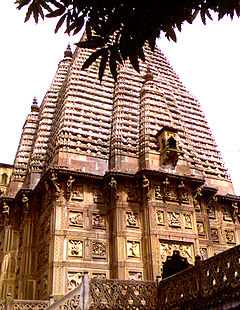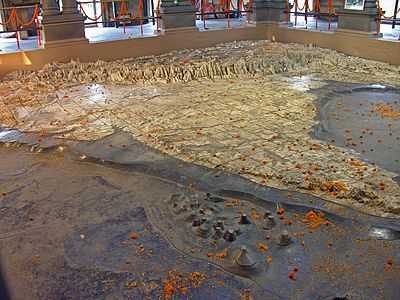Hindu temples in Varanasi
Varanasi is a city of temples. There is a temple near to almost every road crossing. These small temples form the basis of daily local prayers and other rituals. There are also many large temples, erected at different times throughout the history of Varanasi.
Shri Kashi Vishwanath Mandir
Shri Kashi Vishwanath Mandir, also called Golden Temple,[1] which, in its present shape, was built in 1780 by Maharani Ahilyabai Holkar of Indore, is located on the outskirts of the Ganges. This temple makes Varanasi a place of great religious importance to the Hindus, as Vishweshwara or Vishwanatha, the Jyotirlinga of the Lord Shiva, is enshrined here. It is believed that a single view of Vishwanatha Jyotirlinga is worth more than that of other jyotirlingas. A Naubatkhana was built up in front of the Temple by the collector, Mohammed Ibrahim Khan, at the insistence of Governor General, Warren Hastings, in 1785. In 1839, Punjab Kesari, the Sikh Maharaja Ranjit Singh, ruler of the Punjab, donated gold to cover the two domes of the temple. On 28 January 1983, the Temple was taken over by the government of Uttar Pradesh and its management was transferred to a trust with the late Dr. Vibhuti Narayan Singh, then Kashi Naresh, as president and an executive committee with a Divisional Commissioner as chairman.[2]
New Vishwanath Mandir (Birla Mandir)
The New Vishwanath Mandir, also called Birla Mandir, mainly funded by Birla family, was built as a replica of the old Kashi Vishwanath Temple. Planned by Madan Mohan Malaviya, the temple is part of the Banaras Hindu University campus, and represents national revival. The temple is open to people of all castes and religions. There are nine temples in the Sri Vishwanath Temple campus, including Vishwanathji (Shiva Lingam), Natarajji, Mata Parvatiji, Ganesji, Mata Saraswatiji, Panchmukhi Mahadev, Hanumaji, and Nandiji. There are idols of Lord Shiva and Lakshmi Narayanji.

Durga Mandir

Durga Mandir was built in the 18th century. According to legend, the present statue of Goddess Durga was not made by man but appeared on its own in the temple. Thousands of Hindu devotees visit the Durga temple during Navratri and other auspicious occasions.
The architecture is of a Nagara Style, which is typical of North India. The temple has a rectangular tank of water called the Durga Kund ("Kund" meaning a pond or pool.) The temple has multi-tiered spires[1] and is stained red with ochre, representing the red colour of Durga. The Kund was initially connected directly to the river thus the water was automatically replenished. This channel was later closed, locking off the water supply, which is replenished only by rain or drainage from the Temple. Every year on the occasion of Nag Panchami, the act of depicting Lord Vishnu reclining on the coiled-up mystical snake or "Shesha" is recreated in the Kund.
Shri Tilbhandeshwar Mahadev Mandir
This is one of the oldest temples in Varanasi, located near Bengal Tola Inter College and next to the famous weavers colony of Madanpura. It is said that, here, Tilbhandeshwar Shiva Lingam increases by a nominal length every year. Besides Tilbhandeshwar Mahadev, Vibhandeshwar, Maa Parvati, Bhairava, Lord Ayappan and other Hindu deities are visible here. This temple represents a unique combination of Malyali and Banarsi culture. Famous celebrations here include Mahashivratri, Makar Sankranti, Shravan, Navratri, Ayappan Puja etc. Maa Sharda also spent a few days in Varanasi at this temple.

Others
- Bharat Mata Mandir - The Bharat Mata temple at Varanasi is the only temple dedicated to Bharat Mata. It is located on the Mahatma Gandhi Kashi Vidyapeeth campus. The Bharat Mata temple was built by Babu Shiv Prasad Gupt and inaugurated by Mahatma Gandhi in 1936. The statute of Bharat Mata is built in marble and is a model of undivided India, depicting the mountains, plains and oceans. The most peculiar thing about the Bharat Mata Temple is that, instead of the customary gods and goddesses, it houses a relief map of India, carved out of marble.
- Baba Keenaram Sthal - Headquarters and location of the world famous Pilgrim of Aghora sect. Work place of great saint Baba Keenaram. One of the most visited places in Varanasi, by researchers, documentary makers, writers and tourists.
- Vishalakshi temple - This temple is dedicated to Vishalakshi (means wide-eyed) or Parvati, the consort of Lord Shiva.
- Sankat Mochan Temple - Dedicated to Lord Hanuman. It is very popular with locals. It is the location for many yearly religious as well as cultural festivals. On 7 March 2006 one of the three explosions carried out by Islamic militants hit the temple, while the aarti, in which numerous worshippers and wedding attendees participated, was in progress.[3]
- Vyasa Temple at Ramnagar - According to a popular Puranic story, when Vyasa failed to get alms in Varanasi he put a curse on the city.[4] Soon after, at a house where Parvati and Shiva had taken human form as householders, Vyasa was so pleased with the alms he received that he forgot his curse.[4] However, because of his bad temper Shiva banished Vyasa from Varanasi.[4] Resolved to be near at hand, Vyasa took up residence on the other side of the Ganges where his temple may still be seen at Ramnagar.[4]
- Tulsi Manas Mandir - Constructed by the family of Varanasi, this modern temple is dedicated to Lord Rama. It is situated at the place where Tulsidas, the great medieval seer, lived and wrote the epic "Shri Ramcharitmanas", which narrates the life of Lord Rama, the hero of the Ramayana. Verses from Tulsidas’ epic are inscribed on the walls. It is close to the Durga Temple.
- Annapurna Temple - Located near the Kashi Vishwanath temple, there is a nice temple of Devi Annapurna, believed to be the "Goddess of Food". She is a form of Parvati. She is also known as Kashipuraadeeshwari ("Queen of Kasi").
- Sankatha Temple - Near the Sindhia Ghat, there is an important temple of the "Goddess of Remedy," Devi Sankatha. Inside its premises there is a huge statue of a lion. There are also nine temples of nine planets near to this temple.
- Kalbhairav Temple - It is the ancient temple of Varanasi near the main Post Office, VishesharGanj. God KalBhairav is believed to be the "Kotwal Of Varanasi." Without his permission no one can stay in Kashi.
- Mrityunjay Mahadev Temple - This temple of Lord Shiva is situated on the route from Daranagar to the Kalbhairav temple. Just beside this temple there is a well of much religious importance. Its water is said to be a mixture of several underground streams and good for eliminating several diseases.
References
- ↑ 1.0 1.1 "The religious route". The Times of India. 3 April 2003. Retrieved Four December 2008. Check date values in:
|accessdate=(help) - ↑ "Shri Kashi Vishwanath Mandir Varanasi". National Informatics Centre, Government of India. Retrieved February 4, 2007.
- ↑ Sengupta, Somini (9 March 2006). "Indian City Shaken by Temple Bombings". The New York Times. Retrieved 4 December 2008.
- ↑ 4.0 4.1 4.2 4.3 Mitra, Swati (2002). Good Earth Varanasi city guide. Eicher Goodearth Limited. p. 216. ISBN 978-81-87780-04-5.
External links
| ||||||